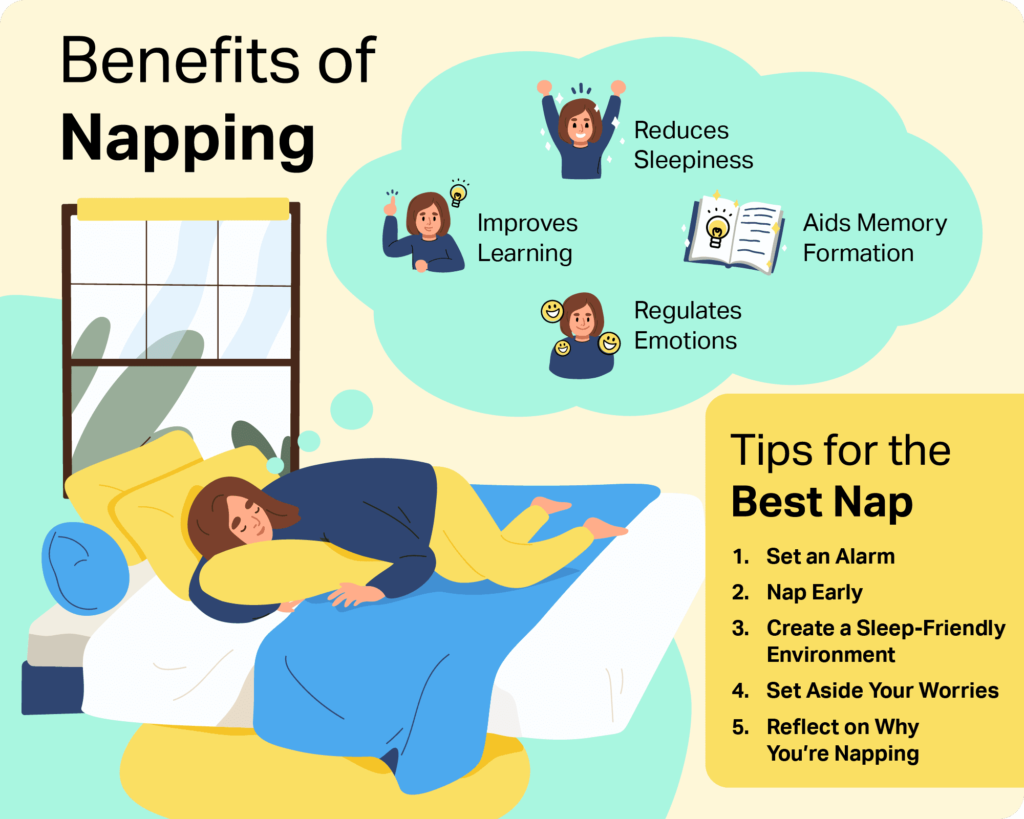
Winston Churchill, Leonardo da Vinci, Thomas Edison, Albert Einstein, and John F Kennedy knew the power of naps so do the Spanish and Italians as well as many in the Mediterranean; what are we missing?
A midday nap can enhance alertness, mood, memory, and reduce stress.A short daytime snooze may also boost workplace performance A nap can improve cognitive functions such as memory, logical reasoning, and the ability to complete complex tasks. Some studies have found that physical performance can also improve after napping. Athletes may experience improved endurance, reaction times, and cognitive performance if they take a daytime nap.
Successful naps must be no more than 20-30 minutes. Longer naps can begin to have negative affects. During a short nap, a person may not be asleep long enough to spend much, if any, time in stage 3 or REM sleep. This can actually make it easier to wake up refreshed from a quick nap. Longer naps, such as those lasting more than 30 minutes, can cause the sleeper to enter deep sleep, and deep sleep may start even sooner in people who are sleep deprived. Grogginess often results from being woken up during deep sleep.
Benefits of napping
- Improved alertness and performance: A short nap can help boost your alertness, concentration, and cognitive performance. It can be particularly helpful if you’re feeling tired or sleepy during the day.
- Enhanced memory consolidation: Napping can aid in consolidating memories and improving memory retention. It allows your brain to process and store information more effectively.
- Mood enhancement: A quick nap can help improve your mood and reduce feelings of stress, anxiety, and irritability.
- Increased creativity: Some research suggests that napping can enhance creative thinking and problem-solving skills by allowing your brain to make new connections and associations.
- Physical rejuvenation: Napping can provide a quick energy boost and help alleviate physical fatigue, especially if you’ve had a poor night’s sleep.
Tips to Take the Best Nap
To get the full benefits from nap time, it is important to consider where, when, and how long to nap. These and other factors can influence how a person will feel after waking up from a nap.
When to Take a Nap
Experts typically recommend that adults take naps eight or more hours before bedtime. For most people, that means napping before 3 p.m. Napping too late in the day may contribute to nighttime sleep problems.
For some people, naps may feel natural or even necessary after lunchtime. This is sometimes known as the post-lunch dip. While eating lunch may play a role in afternoon sleepiness, the post-lunch dip is linked to circadian rhythm. Circadian rhythm is the body’s internal clock that follows a 24-hour cycle. Within this cycle are two peak periods for sleepiness. The greatest peak is during the night, and the second one falls in the early afternoon.
Where to Take a Nap
A good sleep environment is cool, quiet, and dark. Having a comfortable nap setting can help prevent unwanted interruptions or awakenings.
For people who work from home, a bedroom is likely a good place for a short snooze since it is already set up to promote sleep. Adding blackout curtains or a white noise machine to block out distractions may help both at night and during daytime naps.
In an office setting, accessories such as earplugs or an eye mask can reduce disruptions during nap time. When possible, naps should be taken in a space where interruptions are unlikely to occur. Some offices may even have nap pods or other quiet areas for relaxation or a short period of restorative sleep.
Remember to Set an Alarm
Before dozing off during nap time, set an alarm for the desired nap length, which should generally be around 20 minutes.
When the alarm goes off, do not hit snooze to keep sleeping since this can risk entering deeper sleep. Setting a second alarm to go off shortly after the first one may help to avoid napping for too long.
Try to get up as soon as the alarm sounds and then stretch or walk around to shake off any post-nap sleepiness.
Consider Caffeine Naps
People taking a nap to get a boost of energy may benefit from drinking caffeine before napping. The brain and body feel the impact of caffeine about 30 minutes after it is consumed, so having caffeine right before a short nap may increase alertness after waking up.
Change My Napping Habits
Your current napping habits may not fit perfectly with expert recommendations, but that does not necessarily mean the way that you nap is wrong. You should only change your napping habits if you are having problems with your nightly sleep or your daily energy level.
How Do I Start Napping?
You may have to experiment with the timing, duration, and location of your nap. Consider keeping a nap diary where you can record your sleepiness or fatigue levels before and after your nap, as well as where, when, and how long you napped. These recordings can help you track what type of nap is most effective for you.
When Should I Talk to a Doctor?
Excessively napping can also be a symptom of a mental health disorder such as anxiety or depression. Contact your doctor if you are experiencing other related symptoms, such as low mood, change in weight or eating habits, or a lack of interest in activities that you would normally enjoy. Falling asleep unexpectedly or at unwanted times is different from napping and may be a sign of an underlying condition, such as excessive daytime sleepiness or narcolepsy. If you are struggling to get enough sleep at night or are unable to stay awake during normal daytime hours, talk with your health care provider.

Recent Comments